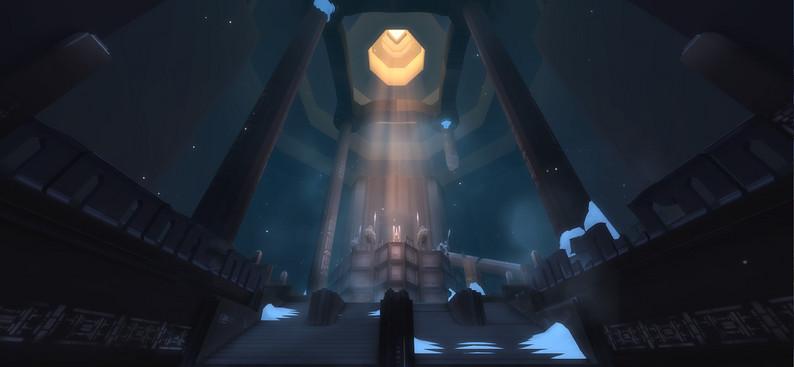“Nothing beside remains. Round the decayOf that colossal Wreck, boundless and bareThe lone and level sands stretch far away.’”– Ozymandias, by Percy Bysshe Shelley
In Requiem, developed by Alberto Carrillo and Anthony Najjar Simon for platforms including Oculus and desktop, is a walking simulator inspired by the poem Ozymandias, by Percy Bysshe Shelley that uses walking as a tool to reflect the vastness and emptiness of a frozen land. The target audience of In Requiem is teens or beyond that enjoy reflecting on abstract ideals within poetry and its visualization.
The player’s objective in this simulator is to race to collect 6 statues before they freeze to death in the frozen landscape. Players follow a map, which restricts them physically as they navigate through dead ends and tunnels. Here, the statues as well as time are both resources, as statues warm up the player for a limited amount of time, which encourages the player to spread out their search to more effectively use the time the statue gives them. The procedure, being a walking simulator, focuses on walking- running and looking around incorporated within this. Walking tells the story as it emphasizes the main point of the poem the game reflects on- the vastness of Ozymandias’ domain, and the vastness of the sands that cover it in the future.
The type of fun this game brings can be considered discovery and sensation- players explore a large, decorated map, and every time they start the game again, the game also starts in a new place. It encourages players to branch out and engage their senses. However, I don’t necessarily believe the game explored these types of fun too well- since there was minimal indication of statistics, such as when you’d freeze to death, how many statues you had left, how much time each statue gave you, etc, I ran through the game incredibly fast in my aim to not freeze, not being able to appreciate the landscape and explore as much as I wanted to. Thus, I’d add these statistics in some inconspicuous way, so players can slow down and appreciate the landscape more. Similarly, whenever a statue was acquired, a new verse from the poem was read aloud. This was, however, drowned out by the background music, and also gave the player no rest to really consider the song. All in all, the lack of clarity on the strictness of the game disoriented me greatly and prevented me from appreciating the journey more. I did however, appreciate the placement within the game- I realized that in a 3d simulator, especially in VR- pointing your player to where you want them to go is very important since they have 360 degrees to look around at. I found the default placings very satisfying, and I wasn’t too disoriented by direction during the game, which says a lot as that often happens to me in any situation. Overall, walking helped drive the point of reflecting on the poem and setting very well- it emphasized the smallness of the player and the lack of power the player had within the realm. This also worked very well with the final scene of the game- now, the vastness and your gait works against Ozymandias and your power is flipped. The slow pace creates proper atmosphere, the main aspect of the poem.



